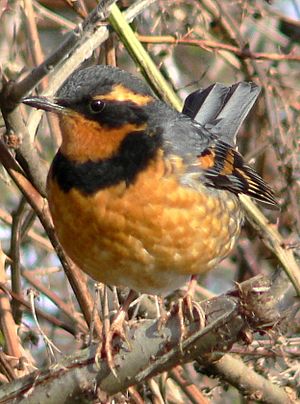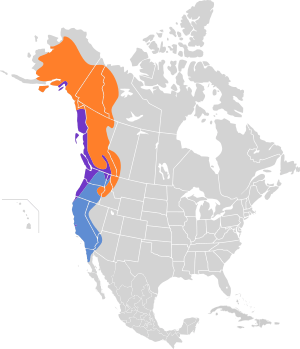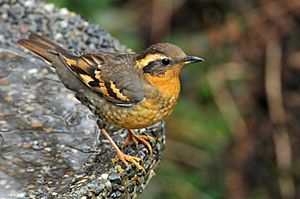Varied thrush facts for kids
Quick facts for kids Varied thrush |
|
|---|---|
 |
|
| Male | |
| Conservation status | |
| Scientific classification | |
| Genus: |
Ixoreus
|
| Species: |
naevius
|
| Subspecies | |
|
|
 |
|
| Synonyms | |
|
|
The varied thrush (Ixoreus naevius) is a cool bird that belongs to the thrush family. It's the only species in its special group, called Ixoreus. This means it's one of a kind!
Contents
About the Varied Thrush Name
The varied thrush was first officially described by a German scientist, Johann Friedrich Gmelin, in 1789. He gave it the scientific name Turdus naevius.
Gmelin based his description on a "Spotted thrush" that another scientist, John Latham, had described earlier in 1783. These birds were found near Nootka Sound in Canada.
Later, in 1854, Charles Lucien Bonaparte created the special group Ixoreus just for this thrush. The name Ixoreus comes from an old Greek word meaning "mistletoe." The word naevius is Latin for "spotted," which makes sense because the bird has spots.
There are four types, or subspecies, of the varied thrush:
- I. n. meruloides – Found in southern Alaska and northwestern Canada.
- I. n. naevius – This is the main type, found in southeastern Alaska and western Canada down to the western central USA.
- I. n. carlottae – Found in Haida Gwaii, a group of islands.
- I. n. godfreii – Found in the Interior Plateau and Columbia Plateau, west of the Rocky Mountains.
What Does a Varied Thrush Look Like?
The varied thrush is a pretty big thrush. It can be about 20 to 26 centimeters (8 to 10 inches) long. Its wings can spread out from 34 to 42 centimeters (13 to 17 inches). These birds usually weigh between 65 and 100 grams (2.3 to 3.5 ounces).
It's similar in size to the American robin, but the varied thrush is a bit shorter and stronger.
Adult male varied thrushes have bright orange and black feathers. They have a curved gray pattern on their chest and throat. Their tail, neck, and head are grayish-blue. They also have dark stripes near their eyes and on their wing feathers. Their beak is dark, but it's tan near the bottom. Their legs are often brownish.
Female varied thrushes have softer colors. Their markings are not as clear, with olive-browns and grays. Young varied thrushes are mostly brown, but their belly feathers are white. They also have two orange stripes on their wing feathers when they are young.
There's a super rare type of this bird where all the orange feathers are white instead! Only a few of these have ever been seen.
Where Do Varied Thrushes Live?
Varied thrushes live in western North America, from Alaska down to northern California. They are migratory birds, meaning they travel. Birds from the north move south for winter. Other groups might just move to lower elevations on mountains.
This bird usually stays in North America. But, one very rare time, a varied thrush was seen in Great Britain in 1982!
They like to build their nests in Alaska, Yukon Territory, and the mountains of British Columbia, Washington, and Oregon. They prefer moist conifer forests, especially older, dense ones in high places.
In winter, they move to lower areas. You might see them in towns, orchards, and thick bushes. Some even fly all the way to California for the winter. They can be seen in groups of up to 20 birds during this time. Sometimes, individual birds fly east in winter, showing up in different states, before returning to the west coast to breed.
What Do Varied Thrushes Eat?
Varied thrushes mostly eat insects and other small creatures like spiders. But their diet changes throughout the year.
In the summer, they mostly eat arthropods that live on the ground. During their travels and in winter, they eat more fruits, seeds, and acorns. They still eat some arthropods, though.
They love many different kinds of berries, including snowberry, red huckleberry, California honeysuckle, madrone, salmonberry, and thimbleberry.
Varied thrushes usually look for food on the ground. But when they're looking for fruits and berries, they'll search in bushes and trees.
Reproduction and Life Cycle
Varied thrushes build their nests in dense coniferous forests. The female usually lays between two and five eggs in a tree nest. Most often, there are 3 or 4 eggs.
The eggs are pale blue with light brown spots. The female bird sits on the eggs to keep them warm, which takes about two weeks. Both parents help feed the baby birds once they hatch. We don't know exactly how long it takes for the young to grow up and leave the nest, but they probably have two groups of babies each year.
Gallery
See also
 In Spanish: Zorzal pinto para niños
In Spanish: Zorzal pinto para niños





